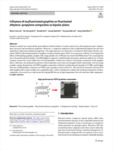

PARTNER
검증된 파트너 제휴사 자료
Influence of oxyfluorinated graphite on fluorinated ethylene–propylene composites as bipolar plates
방대한 850만건의 자료 중 주제별로 만들수 있는 최적의 산출물을 해피 캠퍼스에서 체험 하세요 전문가의 지식과 인사이트를 활용하여 쉽고 폭넓게 이해하고 적용할수 있는 기회를 놓치지 마세요
8 페이지
최초등록일 2023.04.24
최종저작일
2020.06

-
 * 본 문서는 배포용으로 복사 및 편집이 불가합니다.
* 본 문서는 배포용으로 복사 및 편집이 불가합니다.
미리보기
서지정보
· 발행기관 : 한국탄소학회
· 수록지 정보 : Carbon letters / 30권 / 3호
· 저자명 : Moon Hee Lee, Ho Young Kim, Jiwook Kim, Joong Tark Han, Young‑Seak Lee, Jong Seok Woo
목차
Abstract
1 Introduction
2 Experimental
2.1 Materials
2.2 Oxyfluorination of graphite surface
2.3 Fabrication of FEPgraphite composites via compression molding
2.4 Characterization
3 Results and discussion
3.1 Preparation of FEPgraphite and FEPf-graphite composites
3.2 Effect of oxyfluorination on thermal stability and chemical bonding
3.3 Electrical and mechanical properties of FEPgraphite and FEPf-graphite composites
3.4 Surface morphology of FEPf-graphite composites
4 Conclusions
Acknowledgements
References영어초록
Numerous studies have reported that good adhesion and fluorination of carbon materials in a fluoropolymer matrix enhance their electrical and mechanical properties. However, a composite reinforced with oxyfluorinated graphite has not been reported for improving mechanical properties. This paper discusses the fabrication of conductive fluorinated ethylene–propylene (FEP)/oxyfluorinated graphite (f-graphite) composite bipolar plates (BPs) via compression molding. To investigate the effects of fluorinating graphite, graphite with a large particle size of 500 μm was mixed with FEP powder with a small particle size of 8 μm through ball milling. The FEP/graphite composites exhibited high anisotropic electrical conductivity with the in-plane conductivity much higher than the through-plane conductivity because of the planar orientation of the graphite sheets. Therefore, the mechanical properties of the composites such as flexural strength tended to deteriorate with increasing graphite content. In particular, the FEP/f-graphite composites exhibited excellent flexural strength of 12 MPa, much higher than that of FEP/graphite composites at 9 MPa with a graphite content of 80 wt%. The interfacial interaction between FEP and f-graphite led to improved physical compatibilization, which contributed to enhance the mechanical properties of these composites. Our results are a step toward developing BPs for use in high-temperature fuel cells and heat-sink components.참고자료
· 없음태그
-
자료후기
-
자주묻는질문의 답변을 확인해 주세요

꼭 알아주세요
-
본 학술논문은 (주)코리아스칼라와 각 학회간에 저작권계약이 체결된 것으로 AgentSoft가 제공 하고 있습니다.
본 저작물을 불법적으로 이용시는 법적인 제재가 가해질 수 있습니다. -
해피캠퍼스는 구매자와 판매자 모두가 만족하는 서비스가 되도록 노력하고 있으며, 아래의 4가지 자료환불 조건을 꼭 확인해주시기 바랍니다.
파일오류 중복자료 저작권 없음 설명과 실제 내용 불일치 파일의 다운로드가 제대로 되지 않거나 파일형식에 맞는 프로그램으로 정상 작동하지 않는 경우 다른 자료와 70% 이상 내용이 일치하는 경우 (중복임을 확인할 수 있는 근거 필요함) 인터넷의 다른 사이트, 연구기관, 학교, 서적 등의 자료를 도용한 경우 자료의 설명과 실제 자료의 내용이 일치하지 않는 경우
“Carbon letters”의 다른 논문도 확인해 보세요!
-
Heteroatoms in situ‑doped hierarchical porous hollow‑activated carbons.. 14 페이지
-
A complementary analysis of the porous structure of biochars obtained .. 5 페이지
-
Preparation and electrochemical properties of self‑doped nitrogen poro.. 10 페이지
-
Synthesis and characterization of activated carbon produced from waste.. 7 페이지
-
Facile preparation of activated carbon with optimal pore range for hig.. 9 페이지
문서 초안을 생성해주는 EasyAI
